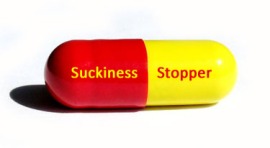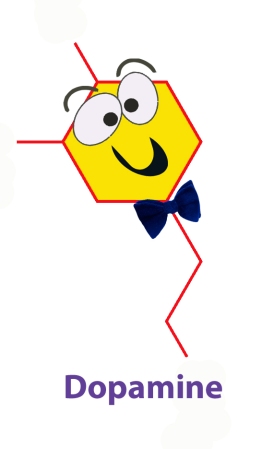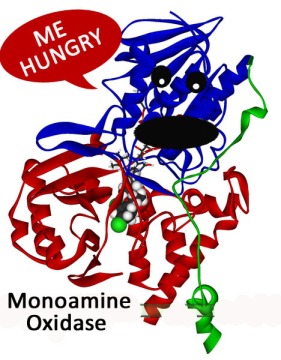Maybe your beloved cat died. Perhaps some super-awesome guy you were dating gave you the old “it’s not you, it’s me” line. It could be that your best friend moved from three blocks away to three time zones away. Maybe you got laid off from your job because the over-paid Execs decided that your position was extraneous and that by eliminating your salary they could increase their profit margins.
No matter which case above applies, they all make you feel the same way: sad.
Sadness is a broad term and has a wide spectrum. Because broad terms and wide spectrums tend to get real confusing real quick, let’s simplify sadness into two basic types: transient sadness and chronic sadness. Transient sadness is when something unfortunate happens and you feel sad for a while, but eventually the sadness passes. Chronic sadness is longer lasting and generally does not pass without some sort of intervention.
 All fancy categorization aside, sadness sucks. In fact, sadness sucks so bad that we’re desperate to alleviate this sucking by inventing bizarrely named medications to stop us from being sad. We’re all pretty familiar with using these Suckiness Stopping medications, right? You swallow a pill for 4 – 6 weeks, during that time the Suckiness Stopping pills start changing something in your brain and eventually, if everything goes as it should, the sucking stops and you feel less sad.
All fancy categorization aside, sadness sucks. In fact, sadness sucks so bad that we’re desperate to alleviate this sucking by inventing bizarrely named medications to stop us from being sad. We’re all pretty familiar with using these Suckiness Stopping medications, right? You swallow a pill for 4 – 6 weeks, during that time the Suckiness Stopping pills start changing something in your brain and eventually, if everything goes as it should, the sucking stops and you feel less sad.
Of course, not all sadness requires Suckiness Stopping pills. But whether you’re transiently sad or chronically sad, something was going on inside your brain to make you feel sad. So what’s that all about? What’s going on in your brain that makes you feel all sucky?
Neurotransmitters.
A neurotransmitter is how your nerve cells talk to each other. A cell sends out a neurotransmitter and another cell picks it up, which gives the receiving cell a message that it needs to be doing something. That cell does what it’s supposed to do, then sends out a neurotransmitter to another cell to tell it what to do next.
Imagine you lock yourself out of your house. It’s February, which means it’s flippin’ cold outside. Your goal is to get the front door unlocked so that you can get back inside the house so that you don’t get all hypothermic and what not. You know that your sister is inside the house, warm and cozy in her bedroom on the second floor. Unfortunately for you, you also left your cell phone inside the house so it’s not like you can call her or anything. You decide that the best way to get her attention is to take a pebble from your driveway and throw it at her window. Your sister hears the pebble hit the glass, goes to the window, opens the window and you tell her to unlock the door because you are freezing and might die (which is an exaggeration of the truth, but whatever, it’s cold outside and you don’t care). Because your sister has a broken leg, she can’t get downstairs to open the door before you die, so instead she yells down the stairs to your mother, who is in the kitchen making a chocolate bundt cake. Your mother hears your sister, wipes her hands on her apron, walks through the living room and to the front door, turns the latch, opens the door and let’s you inside. Goal accomplished. You did not die.
Consider you, your sister and your mother to be nerve cells. Consider throwing the pebble, yelling down the stairs and walking to the door to be the neurotransmitters. This is what is happening inside your brain. And your brain is doing this all the time. Like, constantly. Like, right now. And not just one pebble at a time either. There are thousands of pebbles being thrown around your brain at lightning speed at any given moment. That’s a lot of pebbles.
Each of these pebbles are responsible for sending different messages. Some pebbles are responsible for making you do things that you aren’t even thinking of, like breathing and digesting. Some pebbles are responsible for deciphering the symbols on this page into meaningful representations of concepts so that you can read and understand this blog post.
So which pebbles are responsible for sadness? A few actually.
 These pebbles are called Monoamines. You’re probably familiar with the names of these pebbles: dopamine, serotonin and norepinephrine (also known as noradrenaline). There are other monoamines too, but they’re not really relevant to this article, so they get the shaft (sorry, melatonin). These are your “feel good” neurotransmitters and they each make you feel good in different ways.
These pebbles are called Monoamines. You’re probably familiar with the names of these pebbles: dopamine, serotonin and norepinephrine (also known as noradrenaline). There are other monoamines too, but they’re not really relevant to this article, so they get the shaft (sorry, melatonin). These are your “feel good” neurotransmitters and they each make you feel good in different ways.
Dopamine gets you all excited and motivated and makes you want to do things that feel good. It also remembers what makes you feel good so you are sure to repeat the feel good experience. Dopamine also makes you all yippy-skippy and gets you talking to complete strangers in the elevator because you are, like, totally exploding with feeling-goodness.
Serotonin is the cool, calm and contented feel-good that makes you want to relax on your couch, chill out and listen to some good tunes with some good friends. Serotonin reminds you that life is good and you want to keep it that way. When serotonin was younger, it probably smoked a lot of pot.
Norepinephrine is a lot like dopamine, in that it gets you all excited and wanting to go after things that make you feel good. It also helps you feel confident in stressful situations. Norepinephrine helps you pay attention to things, especially ones that make you feel good, so that you can leap after them with a quickness and get these good things as fast as you can, because you want to feel good as fast as you can. Norepinephrine also helps you make a quick get-away from things that don’t make you feel good.
Dopamine, serotonin and norepinephrine sound like a good time, right? Yep, sure do! They probably sound so good that you think you want as many of these neurotransmitters as possible pumping through your cells, right? Well, not really.
Turns out, “too much of a good thing” is a pretty accurate when it comes to monoamines. At the most basic level, too many monoamines can make you feel too good. Dangerously good. That’s what psychiatrists call “manic”. More specifically, too much dopamine can give you really annoying, not to mention involuntary, muscle movements (also known as tardive dyskineasia). It can also make you paranoid or see and hear things that aren’t really there. Too much serotonin can make you sick to your stomach, pass out and maybe even poop your pants. Too much norepinephrine can make you really angry and want to hurt people.
Too many monoamines = not feeling good.
Fortunately, your body has a way to keep these monoamines under control and on track to feeling good: Monoamine Oxidase. Monoamine Oxidase isn’t a neurotransmitter though; Monoamine Oxidase is an enzyme. Believe it or not, you’ve probably heard of this enzyme before. Does this phrase sound familiar?: “Consult your doctor before taking this medication if you have used an MAO inhibitor in the past.” Yeah, you’ve probably heard it a zillion-and-three times through your TV screen, in an advertisement for some new Suckiness Stopping medication. There are different types of monoamine oxidases (MAO). For purposes of this article, we are only concerned with MAO-A.
Enzymes break chemicals down. MAO-A’s primary function is to break down and consume the monoamines in your body (by using oxygen, which is why it’s called monoamine oxidase. “Oxy” = oxygen, “ase” = enzyme. See? Science isn’t that hard to understand!). When everything in your body is working as it’s supposed to and life is treating you pretty ok, MAO-A meanders out of your liver, into your brain, and gently grazes on the monoamines.
But when your cat dies prematurely at the age of 6, in your arms, from an unknown illness, this signals to your brain that something sad has happened. Now, here’s where it gets foggy. Scientists don’t really know what causes your brain chemistry to change, but they do know which parts of your brain get more activated when you are sad. What’s more, they know that the brain activation from transient sadness and from chronic sadness are not that different from each other. These scientists also know that when people are chronically sad they have fewer monoamines and more MAOs in their brain. Since the brain activation between transient and chronic sadness are similar, scientists conclude that the chemical changes that cause these sadnesses must also be similar.
 When your brain signals that a sad event has occurred, monoamines start hiding out in the nerve cells. Without any feel-good stimulus (like the knowledge that your dead cat will never nuzzle your cheek again), they have no reason to open lines of cheerful communication between your cells because there is nothing to feel cheerful about.
When your brain signals that a sad event has occurred, monoamines start hiding out in the nerve cells. Without any feel-good stimulus (like the knowledge that your dead cat will never nuzzle your cheek again), they have no reason to open lines of cheerful communication between your cells because there is nothing to feel cheerful about.
But don’t forget, your body is still releasing the MAOs, and with food now scarce, they are getting hungry. The MAOs march straight to your brain and consume as many monoamines as possible. For the daring few dopamine, serotonin and norepinephrine that are willing to risk the journey, look out– the MAOs are coming right for you, with fork in hand.
The result is very few monoamines and too many MAOs. Without enough dopamine we feel lethargic, unmotivated, unsocial and experience a sense of longing. Too little serotonin makes us feel emotionally empty, causes problems sleeping, decreased appetite and less interest in pleasurable activities. If there’s not enough norepinephrine, we have a hard time concentrating and we get anxious and fearful.
In short, we are sad.
Being sad sucks. If you’re not reading this article because you’re a huge fan of my amazingly popular blog, chances are you found me because you, too, are sad. But hey, guess what? There’s hope for us, the saddened masses! You know that pint of Ben & Jerry’s Half Baked ice cream you consumed within an hour after super-awesome guy gave you the obligatory, “I still want to be friends”? Or what about that piece of left-over double pepperoni pizza you ate at midnight because you couldn’t sleep after dreaming about the pink slip your boss handed you this morning?
Turns out that comfort food is your ally!
That’s right, there’s evidence that the fatty acids in comfort food improves your mood! The evidence is slim, but at least I don’t have to feel bad about the 20 chicken McNuggets and extra-large Shamrock Shake I housed this afternoon.
*
If you like what you read: Rate, Comment, Subscribe, Share!
If you want to learn more, click any of the links posted throughout the article. The terminology isn’t as user-friendly as what you just read, so if you just want to wallow in sadness with someone for a while, go ahead and email me at CrazyKindaLife@gmail.com and we can be miserable together.
You write so well! You have a dozen different phrases here that could catch a person’s attention, and stay with them after they finish reading.
Your metaphors are brilliant! Anyone can tell that you labored over this article to express complicated subjects in such understandable terms.
And your pictures! People will click Dopey Dopamine just to see what is behind him. It will be something that will benefit them, too.
You give people who read your article something valuable in exchange for their valuable attention. You express your feelings at the same time. In addition to your words, for example, my initial impression of your MAO pic was that of a cat.
But most of all, your article is what people need: to become consciously aware of what is going on with themselves. To connect their sensations and feelings with their thinking. You are helping people do so, although they may not recognize it as such.
Wow, thank you for that incredible compliment!!!